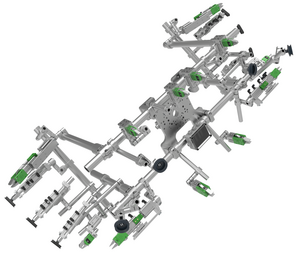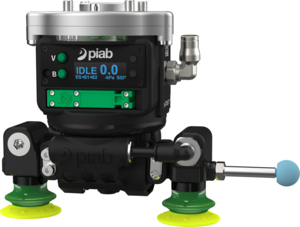Predictive maintenance is usually defined as monitoring performance and condition of equipment during normal operations. This implies that simply providing a highly efficient, reliable and small enough to integrate vacuum ejectors is no longer enough. Vacuum ejectors powering robotic gripping systems such as suction cups, foam grippers etc. for pick and place applications common e.g. in automotive press shops are the interconnection between the gripping unit and the robot and can provide insights into both sides to ensure a smooth-running system.
When digitizing their flagship product to a smart version, the Piab R&D team therefore put a lot of emphasis on supporting the requirements of predictive maintenance to increase their customers’ competitiveness. The piCOMPACT® SMART ejector combines state-of-the-art technology to keep systems up and running at the maximal possible level.
The power of connectivity
Connectivity enables communication with other devices and the cloud through an IO-Link. The Piab R&D team decided on implementing an IO-Link is a further development of existing, tried-and tested connection technology for sensors and actuators. It offers automated parameter setting and enables operators to read and write parameters for various features even during operation. Such a degree of process overview in real-time means that many potential issues can be dealt with before they have any real impact on the production.
The opportunity for system diagnosis allows problems to be identified and corrected more easily and quickly. This has the potential to lead to greatly improved productivity. One of the key factors behind this diagnostic ability is that, contrary to conventional technology, IO-Link offers a data storage function. This enables operators to quickly establish if and why a device or operation might have failed during, for instance, an over-night run. It makes it possible to identify the cause of a failure; perhaps a faulty device needs to be replaced, or the culprit might simply be an incorrect electrical connection. Additionally, if a new, identical substitution device is connected, the parameters of the previous device are automatically transferred saving on precious installation time.
Performing big data analysis
Big data analysis requires measurements of various characteristics to generate the information that can be analysed and used for system optimization. Sensors enable the collection of information that can be used to improve productivity and reduce downtime, facilitating condition monitoring and predictive maintenance. This led to several sensors being added to the system measuring direct operation characteristics of the vacuum ejector for quick detection of potential operational issues such as leakage in the system, the ejector not running well for enabling predictive maintenance. Users can set trigger points and when data deviates and passes such a trigger point, it is an indication that maintenance will be needed soon. This allows preparation, the exchange of only few parts and the avoids unforeseen production line shutdowns.
Therefore, Piab’s R&D team decided to equip piCOMPACT® SMART directly with several diagnostic sensors that support predictive maintenance measuring system temperature current, system voltage, acceleration, cycle counter and system self-check features. Changes in these can indicate that something else is broken in the robot cell or plant. Hence, piCOMPACT® SMART helps to monitor the whole automation systems and prevents any issues with connected or surrounding equipment in addition to increasing understanding of how the ejector itself is running.
A sensor shows the real operating temperature to ensure fast information in case it moves out of this range, which may indicate problems in the closer environment of the ejector. This feature was integrated on the one hand to increase the ejector’s lifetime and ensure its optimal operation but also as an easy to detect warning signal that there may be issues with other system devices that causes temperatures to rise. A voltage sensor controls the power input and determines the operational status.
Predictive maintenance measuring system
The Piab R&D team also intergrated a system self-check of the idle vacuum level that measures the time to reach -15kPA [-6 in HG] below the idle vacuum level initially. This is called First Time To Hit (FTTH). Thereafter, it continues to measure when this point is reached, which is called Time To Hit (TTH). When TTH starts to drift from FTTH there is a leakage, or the ejector is not performing well.
Another important parameter for predictive maintenance of vacuum based robotic gripping systems is obviously the unrestricted air flow or clean, unblocked filters. This can be measured by comparing the Fresh Free-running Vacuum Level (FFVL) to the Free-running Vacuum Level (FVL). Similar to the FTTH and TTH comparison it measures the time needed to reach a certain vacuum level. If the threshold of the allowable limit is passed, it indicates that the vacuum filters may be spoiled and require cleaning or exchange to keep the system running at the required level.
With an eye on the automotive industry with its high degree on automation and handling of large and heavy parts safety of operations plays an important role when the machines are running as well a when maintenance takes place. This led the Piab R&D team to the development of separate power domains for actuators and sensors. Such systems allow activation of the sensor power separately by the operator for maintenance or trouble shooting in the robot cell while leaving actuators disconnected from power supply, so operators are not endangered by moving parts in case e.g. of a short circuit.
The advantage of the separate power domains is that it allows the use of compact style ejectors without separate valve stations. This reduces the cost of installation – as does the fact that usually expensive workarounds or add-on modules to compact ejectors are not required.
Making predictive maintenance feasible the piCOMPACT® SMART from Piab ensures high machine up-times not only for the vacuum system itself but for the whole automation system as it monitors a wide a range of environmental conditions that influence the systems performance.





















